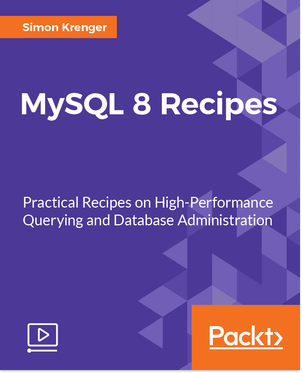In the past few months, I worked closely with Packt Publishing to create a new video course for MySQL 8. Today, the video course was released into the world. I am pround to present to you the new video course “MySQL 8 Recipes“:
In this video course, I tried to include the most common tasks for database administrators while focussing on the new features of MySQL 8. I included the following main chapters:
- Install and configure a new MySQL 8 database
- Upgrade existing databases to MySQL 8
- Perform typical administration tasks
- Master the new querying features in MySQL 8
- Perform performance-tuning tasks
- Optimize your database
- Access databases with PHP, Python, or Java
The video course was released under ISBN-13 9781788393638 and is available per now. Of course, since MySQL 8 is still under development, there will hopefully be many other new features in the new release. But I hope you enjoy this video course. Purchase it here.
With Oracle 12c, Oracle introduced a new way to insert primary keys into tables: The GENERATED BY DEFAULT and DEFAULT keywords.
In this post, I want to compare the performance of different methods to insert a primary key into a table in Oracle. The comparison will also include older methods, such as using a trigger or specifying the primary key in the INSERT statement. These methods can also be used in Oracle versions earlier than 12c.
First of all, let’s look at the possible ways to insert the value of a sequence into a table:
Read the rest of this entry
Since most of our databases are not licensed with the Oracle Enterprise Manager Diagnostic Pack, we cannot use AWR (Automatic Workload Repository) and ADDM (Automatic Database Diagnostic Monitor). So we have to use the good old Oracle STATSPACK.
The goal of this article is to provide a quick reference for installing and maintaining STATSPACK for an Oracle database. It is based on the excellent “STATSPACK Survival Guide” of Akadia AG. If you need more information on STATSPACK, please refer to the Survival Guide or the Oracle documentation, since this article is only a really quick summary on how to install, configure and use STATSPACK.
Read the rest of this entry
The Linux kernel provides the tmpfs, which basically creates a file system in memory. This temporary file system can be used to store temporary data, such as caches or log files. Read more about tmpfs in the kernel documentation: tmpfs.txt
After reading this excellent article about using tmpfs in Linux, I decided to put it to the test. Even though the Linux kernel already does a good job caching files, I wanted to see the performance of this solution by applying different loads on it. For this, I am using the IOzone tool I already used for my ZFS tests (1) (2) and my Amazon EC2 IO test.
Read the rest of this entry
So one might want to ask why you’d want to sacrifice the fantastic stability and openness of Debian to install a vanilla (= original) kernel (Debian currently has 2.6.32). There are quite a few reasons for doing so. For example, the current kernel (2.6.38) has TRIM support, which is something I am looking for when using SSDs. Also, maybe you want to have a bleeding edge kernel just for the fun of it. So lets get started.
First order of business is to download a few packages, download the latest kernel from kernel.org and then unpack the kernel in /usr/src/:
Read the rest of this entry
While discussing the topic of cloud computing today, my co-worker mentioned the Amazon EC2 service and gave me a quick presentation of the features that are available. Since I am a big fan of virtualisation and the idea of scalable architectures, I immediately thought “This could be great to test some things out and is a wonderful opportunity to play around with different virtual machines”. So I signed up and did some quick tests to look at the IO performance…
I was especially interested in using these machines for storage and maybe some tests with databases. For these tests, my current Virtual Server serves as a reference, simply because EC2 could provide an alternative to that Virtual Server. In my tests, I included the following configurations:
Read the rest of this entry
Out of curiosity, I decided to run the IOzone tests I performed with a RAID 10 (see this post) on a RAID-Z and compare it to the RAID 5 of the hardware RAID controller. For this test, I am using IOzone and two older HP DL380 G2 servers.
Read the rest of this entry
As I am currently fiddling around with Oracle Solaris and the related technologies, I wanted to see how the ZFS file system compares to a hardware RAID Controller. The ZFS file system allows you to configure different RAID levels such as RAID 0, 1, 10, 5, 6. In this post, I want to test the RAID 10 performance of ZFS against the performance with the HP RAID Controller (also in a RAID 10 configuration) over 4 disks.
Read the rest of this entry
Because of its minimalistic interface and blazing speed, I am a big fan of Google Chrome. I am using the Developer channel version to get early access to the latest features such as the integrated PDF viewer or GPU acceleration. You can find more information on how to install this version here.
Another nice feature added with the latest version (8.0.552.0 dev as of this writing) is the “Instant” feature. It is basically Google Instant for your browser and greatly accelerates your browsing experience. This Instant feature loads the pages as you are typing in the URL bar of your browser. This means as soon as you see the correct page displayed (while typing), hit Enter and you are already there. Nice!
Read the rest of this entry
